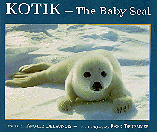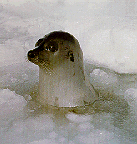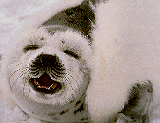


|
Kotik: The Baby Seal.
Angèle Delaunois. Photographs by Fred Bruemmer.
Victoria: Orca Book Publishers, 1995. 48pp, paper, $9.95.
ISBN: 1-55143-050-9. CIP.
Subject Headings:
Harp seal-Infancy-Juvenile literature.
Seals (Animals)-Infancy-Juvenile literature.
Grades 3 - 6 / Ages 8 - 11.
Review by Carol Carver.
*/4
|
excerpt:
March 1. Kotik is four days old. Since his birth, brilliant sunshine has
been casting millions of blue shadows on the ice pack and making
sparkling paths shimmer in the emerald green of the sea. Asleep in his
cradle of ice, the baby seal is quite oblivious of the short-lived magic
of the light. Belly up, he lies dreaming, with his tummy well filled and
his two flipper-arms wrapped around his warm little body. He has changed
a lot since he was born. The scrawny new-born lost in his too-large skin
has become a plump little whitecoat. His mother's milk is so rich that in
just four days he has put on three kilos. You could even say that he is
growing right before our eyes.
 This third in a series about Arctic animals by Angèle Delaunois tells of the birth,
abandonment, and growing independence of little Kotik, a harp seal.
Information is set out by date, beginning on February 24, when seals are
arriving at ice floes in the Gulf of Saint Lawrence to give birth to
their young, and ending three and a half months later with Kotik's
arrival on the shores of Greenland. We see events through the eyes of the
seals: the mother's as she prepares to bear her young, then leaves with
the other adults; and Kotik's from the moment of birth, to losing his
white coat, and finally learning to survive on his own.
This third in a series about Arctic animals by Angèle Delaunois tells of the birth,
abandonment, and growing independence of little Kotik, a harp seal.
Information is set out by date, beginning on February 24, when seals are
arriving at ice floes in the Gulf of Saint Lawrence to give birth to
their young, and ending three and a half months later with Kotik's
arrival on the shores of Greenland. We see events through the eyes of the
seals: the mother's as she prepares to bear her young, then leaves with
the other adults; and Kotik's from the moment of birth, to losing his
white coat, and finally learning to survive on his own.
The language has a poetic feel, as in "sparkling paths shimmer in
the emerald green of the sea," which can be lovely but does not seem
quite appropriate for a scientific book. The lengthy descriptive
vocabulary (for example, "In the increasing light of the lengthening
days, the microscopic plants that make up the vegetable plankton bloom on
the surface of the water, mottling it here and there with a
phosphorescent green glimmer") could lead to further problems. If too
challenging for children to read, few will choose this book. Perhaps it
is most suitable for read-aloud. Because of the mature language, it is
difficult to give an appropriate grade level for the book.

The seals have been highly anthropomorphized. For example, after the
mothers have left, Delaunois writes, "Deserted by the adults, the vast
floating nurseries are peopled by desperate or resigned baby seals who,
like Kotik, are suspended in a motionless present, waiting for life to
carry on." Attributing human characteristics to animals is not
appropriate in non-fiction.
The photographs by Bruemmer, including many close-ups, are the
highlight of the book. However, they lack captions and it is not always
easy to tell what the photo is about. Twenty words in the text are
italicized and explained in the glossary at the end, but they vary from
the very easy "snout" to the highly complex "amniotic sack [or fetal
membrane]," defined as "an internal membrane enveloping the fetus, the
scientific name for which is `amnios'." There are no subtitles, which
would make locating information easier, only dates, but the type is easy
to read.
Schools looking for a highly informative book on seals are directed
to Barkhausen and Geiser's Animal Families: Seals.
Not recommended.
Carol Carver is a Primary Teacher at École Dieppe School in
Winnipeg.
To comment on this title or this review, send mail to cmeditor@mts.net.

Copyright © 1996 the Manitoba Library Association.
Reproduction for personal use is permitted only if this copyright notice
is maintained. Any other reproduction is prohibited without permission.
Published by
The Manitoba Library Association
ISSN 1201-9364

CONTENTS FOR THIS ISSUE |
WELCOME


![]()

 This third in a series about Arctic animals by Angèle Delaunois tells of the birth,
abandonment, and growing independence of little Kotik, a harp seal.
Information is set out by date, beginning on February 24, when seals are
arriving at ice floes in the Gulf of Saint Lawrence to give birth to
their young, and ending three and a half months later with Kotik's
arrival on the shores of Greenland. We see events through the eyes of the
seals: the mother's as she prepares to bear her young, then leaves with
the other adults; and Kotik's from the moment of birth, to losing his
white coat, and finally learning to survive on his own.
This third in a series about Arctic animals by Angèle Delaunois tells of the birth,
abandonment, and growing independence of little Kotik, a harp seal.
Information is set out by date, beginning on February 24, when seals are
arriving at ice floes in the Gulf of Saint Lawrence to give birth to
their young, and ending three and a half months later with Kotik's
arrival on the shores of Greenland. We see events through the eyes of the
seals: the mother's as she prepares to bear her young, then leaves with
the other adults; and Kotik's from the moment of birth, to losing his
white coat, and finally learning to survive on his own.
![]()
![]()